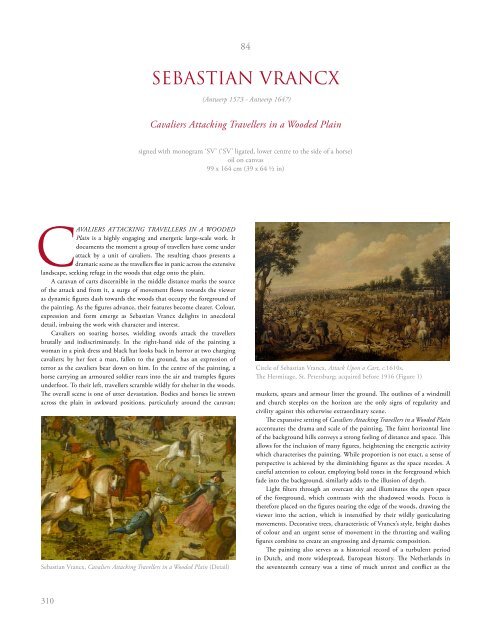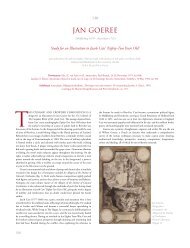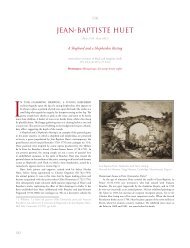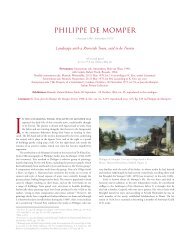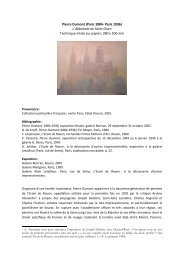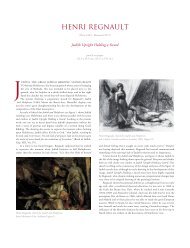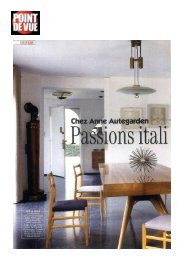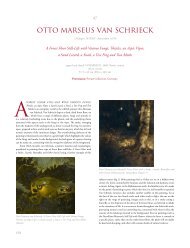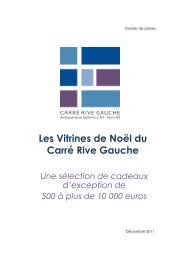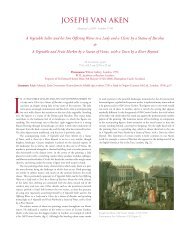SEBASTIAN VRANCX - Jacques d'Arthois - An Extensive Wooded ...
SEBASTIAN VRANCX - Jacques d'Arthois - An Extensive Wooded ...
SEBASTIAN VRANCX - Jacques d'Arthois - An Extensive Wooded ...
Create successful ePaper yourself
Turn your PDF publications into a flip-book with our unique Google optimized e-Paper software.
cAvAliers ATTACking TrAvellers in A <strong>Wooded</strong><br />
Plain is a highly engaging and energetic large-scale work. It<br />
documents the moment a group of travellers have come under<br />
attack by a unit of cavaliers. The resulting chaos presents a<br />
dramatic scene as the travellers flee in panic across the extensive<br />
landscape, seeking refuge in the woods that edge onto the plain.<br />
A caravan of carts discernible in the middle distance marks the source<br />
of the attack and from it, a surge of movement flows towards the viewer<br />
as dynamic figures dash towards the woods that occupy the foreground of<br />
the painting. As the figures advance, their features become clearer. Colour,<br />
expression and form emerge as Sebastian Vrancx delights in anecdotal<br />
detail, imbuing the work with character and interest.<br />
Cavaliers on soaring horses, wielding swords attack the travellers<br />
brutally and indiscriminately. In the right-hand side of the painting a<br />
woman in a pink dress and black hat looks back in horror at two charging<br />
cavaliers; by her feet a man, fallen to the ground, has an expression of<br />
terror as the cavaliers bear down on him. In the centre of the painting, a<br />
horse carrying an armoured soldier rears into the air and tramples figures<br />
underfoot. To their left, travellers scramble wildly for shelter in the woods.<br />
The overall scene is one of utter devastation. Bodies and horses lie strewn<br />
across the plain in awkward positions, particularly around the caravan;<br />
Sebastian Vrancx, Cavaliers Attacking Travellers in a <strong>Wooded</strong> Plain (Detail)<br />
310<br />
84<br />
<strong>SEBASTIAN</strong> <strong>VRANCX</strong><br />
(<strong>An</strong>twerp 1573 - <strong>An</strong>twerp 1647)<br />
Cavaliers Attacking Travellers in a <strong>Wooded</strong> Plain<br />
signed with monogram ‘SV’ (‘SV’ ligated, lower centre to the side of a horse)<br />
oil on canvas<br />
99 x 164 cm (39 x 64 ½ in)<br />
Circle of Sebastian Vrancx, Attack Upon a Cart, c.1610s,<br />
The Hermitage, St. Petersburg; acquired before 1916 (Figure 1)<br />
muskets, spears and armour litter the ground. The outlines of a windmill<br />
and church steeples on the horizon are the only signs of regularity and<br />
civility against this otherwise extraordinary scene.<br />
The expansive setting of Cavaliers Attacking Travellers in a <strong>Wooded</strong> Plain<br />
accentuates the drama and scale of the painting. The faint horizontal line<br />
of the background hills conveys a strong feeling of distance and space. This<br />
allows for the inclusion of many figures, heightening the energetic activity<br />
which characterises the painting. While proportion is not exact, a sense of<br />
perspective is achieved by the diminishing figures as the space recedes. A<br />
careful attention to colour, employing bold tones in the foreground which<br />
fade into the background, similarly adds to the illusion of depth.<br />
Light filters through an overcast sky and illuminates the open space<br />
of the foreground, which contrasts with the shadowed woods. Focus is<br />
therefore placed on the figures nearing the edge of the woods, drawing the<br />
viewer into the action, which is intensified by their wildly gesticulating<br />
movements. Decorative trees, characteristic of Vrancx’s style, bright dashes<br />
of colour and an urgent sense of movement in the thrusting and wailing<br />
figures combine to create an engrossing and dynamic composition.<br />
The painting also serves as a historical record of a turbulent period<br />
in Dutch, and more widespread, European history. The Netherlands in<br />
the seventeenth century was a time of much unrest and conflict as the
Sebastian Vrancx, Ambush, c.1630,<br />
National Gallery, Prague (Figure 2)<br />
region struggled to resolve political and religious tensions, largely initiated<br />
by Spanish imperial ambitions. In a factionalized state with competing<br />
ideologies and local militia, attacks of the nature depicted in the present<br />
painting were not an uncommon occurrence. Such subjects became a<br />
popular theme for many Dutch artists, particularly Vrancx, who was best<br />
known for his depiction of battle scenes.<br />
He started painting small-scale cavalry scenes early in his career and<br />
they earned him particular renown. Of special note is his untraced Battle<br />
between officers lekkerbeetje and Bréauté on the Heath of vught (1601), of<br />
which numerous versions survive, including an incorrectly attributed copy.<br />
Over half of Vrancx’s oeuvre is devoted to this subject matter. Apart from Jan<br />
Snellinck (1544/49-1638), he was the first artist to attempt the subject of<br />
cavalry battles and thus one of its principal exponents in the Netherlands.<br />
He was followed in the southern Netherlands by Pieter Meulener (1602-<br />
1654) and <strong>Jacques</strong> van der Wijhen (b. c.1588) and in France by Adam-<br />
Frans van der Meulen (1632-1690), who was a pupil of Pieter Snayers<br />
(1592-1667), himself a pupil of Vrancx. In the northern Netherlands,<br />
Vrancx’s influence is clearly evident in the work of Esaias van de Velde<br />
312<br />
(1587-1630) (see inventory) and Pauwels van Hillegaert (1595/96-1640).<br />
The conservativeness of Vrancx’s cavalry scenes often draw him parallels<br />
with <strong>An</strong>tonio Tempesta (1555-1630) (see inventory). Tempesta was a<br />
Florentine painter and printmaker, chiefly remembered for his hunting and<br />
battle scenes. A great number of his prints were widely circulated across<br />
Europe with which Vrancx may well have come into contact.<br />
Of a similar subject to the present painting is Attack Upon a Cart<br />
belonging to the circle of Vrancx, now housed in the Hermitage, St.<br />
Petersburg (fig. 1). Once again, a scene of brutality is presented as soldiers<br />
attack a cart. Set similarly within an expansive yet conventional landscape,<br />
a large battle wages in the background while the foreground details reveal<br />
the consequences of the attack. A group of cavaliers in the right-hand side<br />
of the painting casually survey the scene as figures flee, bodies are pillaged<br />
and the remnants of war are strewn across the landscape. While the painting<br />
represents the horrors of battle, it lacks the vibrancy and dynamism of<br />
Cavaliers Attacking Travellers in a <strong>Wooded</strong> Plain. Bolder colour and a freer,<br />
more decorative approach taken in the present painting lends the work<br />
greater character and expression, embodied in the personal attention<br />
accorded to individual figures - their gesticulating and expressive qualities<br />
allowing for a greater sense of identification in the viewer. The result is a<br />
more accomplished and engaging painting.<br />
Vrancx depicted similar scenes of banditry and surprise attacks<br />
throughout his career, another example being Ambush (fig. 2). In this<br />
work, similarly set on an isolated wooded track, the latter stages of the<br />
attack are depicted; captured woman are led to one side whilst their male<br />
companions are marched into the darkness of the wood on the left-hand<br />
side. <strong>An</strong> escapee is about to be shot and a dead horse provides further<br />
evidence of the attackers’ violence. Details, such as the pleading of the<br />
woman dressed in white or the fact that another of the victims is a monk,<br />
poignantly emphasise the cruelty depicted.<br />
Vrancx was the son of Jan Vrancx and Barbara Coutereau. The<br />
biographer of Netherlandish artists Karel van Mander (1548-1606) claimed<br />
Vrancx trained as a painter with Adam van Noort (1561/62-1641), which<br />
is possible but unconfirmed. Vrancx’s earliest known work, a drawing, is<br />
closely related to the <strong>An</strong>twerp scrollwork decorations of Cornelis Floris<br />
(1514-1575) and Cornelis Bos (1506-c.1564). The next drawings and<br />
paintings were executed during Vrancx’s stay in Italy (c.1596-1601) and<br />
Sebastian Vrancx, Cavaliers Attacking Travellers in a <strong>Wooded</strong> Plain (Detail) Sebastian Vrancx, orpheus and the Beasts, c.1595,<br />
Galleria Borghese, Rome (Figure 3)
Joos de Momper II, river landscape with Boar Hunt, c.1610,<br />
Rijksmuseum, Amsterdam (Figure 4)<br />
reveal strong parallels with the early style of Paul Bril (1554-1626), who<br />
was working in Rome, and of Jan Brueghel I (1568-1625). They contain<br />
the hallmarks that distinguish Vrancx’s work - a liking for anecdotal detail<br />
and colourful and gesticulating figures within a decorative landscape.<br />
In 1610, Vrancx became a member of the Fraternity of Saint Peter and<br />
Saint Paul, a select society whose members included Sir Peter Paul Rubens<br />
(1577-1640). In the Guild year 1611-1612 he was an associate dean and<br />
in the following year chief dean of <strong>An</strong>twerp’s Guild of St. Luke. In 1612,<br />
he married Maria Pamphi, daughter of an art dealer and sister-in-law of<br />
the painter Tobias Verhaecht (1561-1631), who later became his daughter’s<br />
godfather.<br />
Vrancx’s oeuvre is not exclusively preoccupied with battle scenes;<br />
it includes many accomplished allegorical, mythological and religious<br />
subjects, which he presented as genre scenes with the emphasis on narrative<br />
detail. orpheus and the Beasts is one example, which depicts Orpheus, chief<br />
among poets and musicians, taming wild animals with his music and<br />
singing (fig. 3). The mythological subject was popular among artists, which<br />
allowed for the depiction of many animals gathered together, thereby<br />
providing an opportunity for the artist to demonstrate his expertise.<br />
Vrancx was also a member of the violieren (‘Stocks’), part of a larger<br />
literary movement known as the <strong>An</strong>twerp chamber of rhetoricians, who<br />
played an important part in the literary scene in the Dutch Golden Age.<br />
Comprising various societies, they flourished in the Low Countries in the<br />
fifteenth and sixteenth centuries, experimenting in poetry and drama. In<br />
addition to his literary involvement, Vrancx also produced paintings for<br />
the violieren, which had ties with the <strong>An</strong>twerp Guild of St. Luke.<br />
Vrancx collaborated with many other leading Dutch artists throughout<br />
his career. On several occasions he provided the staffage for Joos de Momper<br />
II’s (1564-1635) (cat nos. 48 & 80) celebrated paintings, including river<br />
landscape with Boar Hunt, currently in the Rijksmuseum, Amsterdam (fig.<br />
4). Similarly, Vrancx worked with Jan Brueghel I on subjects familiar to<br />
him, such as raid on a Convoy in the Kunsthistoriches Museum, Vienna. The<br />
artist also collaborated with Tobias Verhaecht (1561-1631) (e.g. Hunting<br />
Adventure of emperor Maximilian i, Brussels), Alexander Keirinck (1600-<br />
1642) (e.g. landscape with Chasing Horsemen, Darmstadt), Jan van Balen<br />
(1611-54) and Frans Francken II (1581-1642) (cat no. 36) (see rebus Arms<br />
for the violieren, 1618, <strong>An</strong>twerp) and Pieter Neeffs (active 1605-1656/61)<br />
(cat. nos. 36 & 37) (see Church interior, 1613, Brussels). Whenever Vrancx<br />
is recorded as working with other artists, it is he who provides the figures.<br />
In his own work, however, Vrancx usually painted the landscapes himself.<br />
Vrancx’s stylistic development c.1611-1625 reveals a more confident<br />
handling of form in his figures and landscapes, which came to characterise<br />
Sebastian Vrancx, Cavaliers Attacking Travellers in a <strong>Wooded</strong> Plain (Detail)<br />
his mature style. His representation of space, and large, complex groups<br />
within, was executed with far greater control and clarity. This developed<br />
to a new level in the latter part of his career, from c.1625 to 1647, when<br />
Vrancx gave greater emphasis to the space than the figures in his paintings.<br />
A refinement, which originated c.1620 in the ‘aristocratic’ characterisation<br />
of horses, became a feature of the whole image, while the painting of trees<br />
became more ‘woolly’. Vrancx continued painting until the end of his life,<br />
with his final works exchanging strength for gracefulness.<br />
Vrancx enjoyed a successful and diverse career, collaborating with<br />
leading contemporary Dutch artists and experimenting in a variety of genres<br />
as well as being an active member of the violieren. It was for his paintings of<br />
battle scenes, however, which Vrancx introduced to the Netherlands, that<br />
he is best remembered. Scenes of war and pillage were the chief motifs for<br />
the artist and in their representations he was arguably unrivalled. Whilst<br />
pictorial documents of a turbulent period of Dutch history, they are also<br />
highly accomplished works in their own right. Vrancx’s delight in detail,<br />
excellent employment of colour and space and most distinctly, superbly<br />
animated figures, lend his work a dynamism and energy. It is these qualities<br />
that underpin the success of his paintings, and which were to establish his<br />
reputation as a leading artist of his time, a proponent of battle scenes and<br />
a significant influence on future generations.<br />
Sebastian Vrancx, Cavaliers Attacking Travellers in a <strong>Wooded</strong> Plain (Detail)<br />
313


